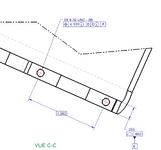supergee
Mechanical
- Aug 15, 2012
- 78
I was trying to think of a practical use of LMC when I realised that, though it is not forbiden in ASME y14.5 2018... it doesn't seem to make sense... at least with a patter of holes. The LMC enable one to have bonus tolerancing when material departs from LMC. one cannot increase that bonus further. am I right to understand that?? here is an example. (please disregard that the holes are threaded... it's beside the point here) the only thing that would make sense, if allowable, is a multisgment positionnal tolerance right?


